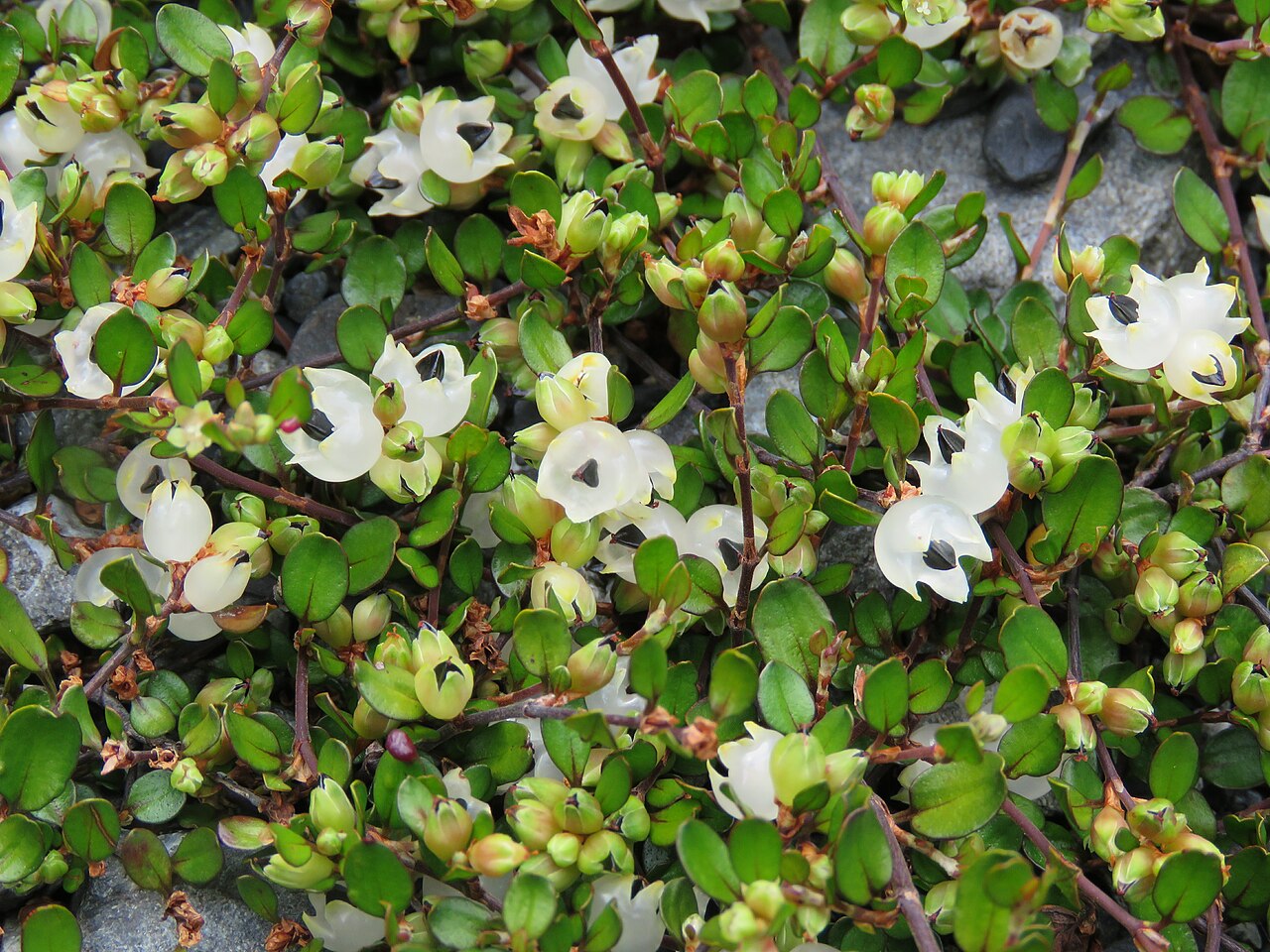Creeping Fuchsia
Fuchsia procumbens
Fuchsia procumbens, commonly known as Creeping Fuchsia, is a unique prostrate shrub endemic to coastal areas of New Zealand's North Island. Unlike typical fuchsias, this remarkable plant grows as a ground cover with slender, creeping stems that form a dense mat. Its most distinctive feature is its unusual upward-facing flowers with bright yellow and orange-green coloration, followed by large, edible red berries. This rare and fascinating native plant combines ornamental appeal with ecological significance.

Image credit: Wikipedia
Quick Facts
| Height | 5-10 cm |
|---|---|
| Spread | 0.5-1 meter |
| Water Needs | Moderate |
| Light | Partial shade to full shade |
| Frost Tolerance | Moderate |
| Growth Rate | Slow to moderate |
| Lifespan | Perennial |
Climate Best Suited To
Creeping Fuchsia is native to coastal areas of the northern North Island of New Zealand. It naturally occurs in sandy soils near tide lines in mild, temperate climates with moderate rainfall. In cultivation, it prefers cool, moist conditions with protection from hot afternoon sun and drying winds.
Regional Suitability
| City | Climate Suitability |
|---|---|
| Whangārei | Ideal |
| Auckland | Ideal |
| Hamilton | Ideal |
| Tauranga | Ideal |
| Rotorua | Ideal |
| Gisborne | Moderate |
| New Plymouth | Ideal |
| Napier | Moderate |
| Whanganui | Moderate |
| Palmerston North | Moderate |
| Wellington | Moderate |
| Nelson | Moderate |
| Christchurch | Challenging |
| Dunedin | Challenging |
| Invercargill | Challenging |
Growing Requirements
Soil Requirements
Creeping Fuchsia prefers:
- Well-draining but moisture-retentive soil
- Rich in organic matter
- Slightly acidic to neutral pH (6.0-7.0)
- Sandy or loamy texture
- Consistent moisture without waterlogging
- Mulch to maintain cool root zone
Light Requirements
This shade-loving ground cover prefers:
- Partial to full shade
- Morning sun with afternoon shade
- Filtered light under trees
- Protection from direct, hot sunlight
- Bright shade for best flowering
- Cooler positions in warmer regions
Water Requirements
Consistent moisture is important:
- Regular watering, especially during establishment
- Keep soil consistently moist but not soggy
- More frequent watering during dry periods
- Reduce watering in winter
- Mulch to retain soil moisture
- Good drainage to prevent root rot
Temperature Tolerance
Creeping Fuchsia prefers mild conditions:
- Ideal growing temperature: 15-22°C
- Moderate frost tolerance once established
- Protect from severe frosts below -5°C
- Dislikes extreme heat
- May go dormant in very hot conditions
- Prefers cool root zone
Planting & Care
Planting Tips
For successful establishment:
- Plant in spring or early autumn
- Space plants 30-40cm apart
- Prepare soil with compost and organic matter
- Plant at the same depth as the nursery container
- Water thoroughly after planting
- Apply a layer of mulch around plants
- Protect from strong winds during establishment
- Consider planting near rocks or logs for support
Pruning
Minimal pruning required:
- Remove dead or damaged stems as needed
- Trim back after flowering to maintain shape
- Cut back overly long stems to encourage branching
- Avoid heavy pruning which can reduce flowering
- Prune in late winter or early spring
- Can be cut back harder if becoming straggly
- Use clean, sharp tools to prevent disease spread
Fertilizing
Light feeding is sufficient:
- Apply slow-release native plant fertilizer in spring
- Use low-phosphorus formulations
- Avoid high-nitrogen fertilizers
- Apply compost or well-rotted manure annually
- Mulch with leaf mold to add nutrients gradually
- Reduce fertilizing in winter
- Avoid fertilizing during drought conditions
Common Issues
Watch for these problems:
- Slugs and snails may damage new growth
- Aphids occasionally affect tender shoots
- Root rot in poorly drained soils
- Leaf scorch in too much direct sun
- Reduced flowering in deep shade
- Frost damage to tender growth
- Drying out in hot, windy conditions
Propagation
Cuttings
The most reliable method:
- Take 5-10cm softwood or semi-hardwood cuttings in spring or summer
- Remove lower leaves, leaving 2-3 pairs at top
- Dip cut end in rooting hormone (optional)
- Insert into a mix of peat and perlite or quality cutting mix
- Keep consistently moist but not wet
- Place in bright, indirect light
- Cover with clear plastic to maintain humidity
- Roots should develop within 3-6 weeks
- Transplant when well-rooted
Seeds
For genetic diversity:
- Collect ripe red berries
- Extract seeds by mashing fruit and washing pulp away
- Dry seeds briefly before sowing
- Sow fresh seeds in autumn or winter
- Use a well-draining seed-raising mix
- Cover seeds lightly with fine grit or sand
- Keep consistently moist but not wet
- Germination occurs in 3-6 weeks at 18-22°C
- Transplant seedlings when they have several true leaves
Division
For established plants:
- Divide established plants in early spring
- Carefully lift the plant with a garden fork
- Gently separate rooted sections
- Ensure each division has adequate roots and stems
- Replant divisions at the same depth as before
- Water thoroughly after planting
- Keep soil consistently moist until established
- Provide shade for a few weeks after division
Layering
Takes advantage of natural growth habit:
- Select a healthy, flexible stem
- Pin it to the ground with a garden staple or stone
- Cover the pinned section with soil, leaving the tip exposed
- Keep soil consistently moist
- Roots will form at the soil contact points within a few months
- Once well-rooted, cut from parent plant and transplant
Cultural History
Creeping Fuchsia has a unique place in New Zealand's natural and cultural heritage:
Traditional Māori Knowledge
- Limited documented traditional uses compared to other native plants
- Berries were occasionally eaten, though not a primary food source
- Recognized as part of the natural coastal landscape
- Valued for its distinctive appearance
Ecological Significance
- Endemic to New Zealand's North Island coastal areas
- Provides ground cover in coastal ecosystems
- Berries may be dispersed by native lizards and invertebrates
- Unusual pollination biology with both male and female plants
- Represents a unique evolutionary adaptation in the Fuchsia genus
- Diverged from other New Zealand Fuchsia species around 18 million years ago
European Settlement Impact
- Documented by botanist Richard Cunningham in 1839
- Coastal habitat reduced through development
- Recognized for its ornamental potential
- Introduced to international horticulture
- Now grown worldwide as a garden plant
Contemporary Significance
Today, Creeping Fuchsia is valued both for its ecological role and as an ornamental plant. Its unusual upward-facing flowers and prostrate growth habit make it popular for rock gardens, hanging baskets, and as a ground cover. Conservation efforts include habitat protection and cultivation for restoration projects. It has been categorized as "At risk – naturally uncommon" in New Zealand's threatened plant list, highlighting the importance of conservation efforts.
Pests & Diseases
Common Pests
- Slugs and Snails: Often damage new growth and flowers. Control with organic baits or barriers.
- Aphids: May infest new growth. Wash off with water spray or treat with insecticidal soap.
- Scale Insects: Occasionally appear on stems. Control with horticultural oil or insecticidal soap.
- Mealybugs: Sometimes found in dense growth. Treat with insecticidal soap or neem oil.
Common Diseases
- Root Rot: Caused by overwatering or poor drainage. Ensure well-draining soil and avoid waterlogged conditions.
- Powdery Mildew: May appear in humid conditions with poor air circulation. Improve spacing and air flow.
- Leaf Spot: Various fungi can cause spotting on leaves. Remove affected foliage and improve air circulation.
- Botrytis: Gray mold that can affect flowers and stems in damp conditions. Improve air circulation and avoid overhead watering.
Environmental Issues
- Heat Stress: In very hot conditions, foliage may wilt or brown at edges. Provide afternoon shade in hot regions.
- Frost Damage: Young growth can be damaged by severe frosts. Protect with frost cloth during cold snaps.
- Waterlogging: Cannot withstand constantly wet soil. Ensure good drainage.
- Drought Stress: Will decline if soil becomes too dry. Maintain consistent moisture, especially in summer.
Creeping Fuchsia is generally resilient to pests and diseases when grown in appropriate conditions. Most issues can be prevented by providing good drainage, appropriate light levels, and consistent moisture without overwatering. Regular monitoring will help catch any problems early.
Bonus Tip
Create a stunning hanging basket display with Creeping Fuchsia by planting it in a shallow, wide basket where its trailing stems can cascade over the edges. For the best effect, position the basket where you can view the flowers from below, as they face upward unlike most fuchsias. Combine with small native ferns like Asplenium flabellifolium (Necklace Fern) for textural contrast. Water consistently but allow the top centimeter of soil to dry slightly between waterings to prevent root rot. In autumn, the bright red berries add another season of interest to this unique display. This arrangement works beautifully in a sheltered porch or under the canopy of a tree where the plant receives filtered light.


